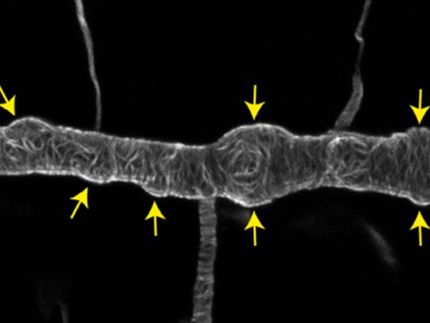Growth in cerebral aneurysms increases risk of rupture
Cerebral aneurysms of all sizes—even small ones below seven millimeters—are 12 times more likely to rupture if they are growing in size, according to a new study published online in the journal Radiology.
A cerebral aneurysm is a balloon-like bulge in a weakened blood vessel in the brain. If an aneurysm ruptures, blood is leaked into or around the brain, which can cause brain damage or death.
According to The Brain Aneurysm Foundation, an estimated 6 million people in the United States have an unruptured brain aneurysm, or 1 in 50 people. Ruptured brain aneurysms occur in approximately 30,000 Americans each year and are fatal in about 40 percent of cases. Of those who survive, about two-thirds suffer some permanent neurological deficit.
"Given what a devastating event a ruptured brain aneurysm is, we are very motivated to identify the real risk factors for rupture," said the study's lead author, J. Pablo Villablanca, M.D., chief of diagnostic neuroradiology at the David Geffen School of Medicine at the University of California, Los Angeles.
In Dr. Villablanca's study, 258 asymptomatic cerebral aneurysms identified either incidentally or during a baseline study of 165 patients (132 women, 33 men) were monitored over time (mean of 2.24 years) with computed tomography angiography (CTA), a noninvasive imaging study of the brain's blood vessels. Patients were scanned with CTA at intervals of six or 12 months.
Over the study period, the researchers observed growth in 46 or nearly 18 percent of all the intracranial aneurysms in a total of 38 patients. Three of the 39 growing saccular aneurysms ruptured, and of those, all were less than seven millimeters in size at study entry.
"Our study shows that the size of the aneurysm is not as important as was once thought," Dr. Villablanca said. "Any aneurysm is potentially capable of growth and thus requires follow-up imaging."
Current guidelines based on research conducted by the International Study of Unruptured Intracranial Aneurysms and other studies suggest that known aneurysms less than seven millimeters in size have a low risk of rupture and do not need to be monitored with imaging.
Compared to the aneurysms that stayed the same size, the 46 growing aneurysms in the study were associated with a 12-fold higher risk of rupture. The researchers calculated the risk of rupture for growing aneurysms at 2.4 percent per patient-year, versus 0.2 percent for aneurysms without growth.
"Our data support the need to perform longitudinal follow-up imaging to monitor for possible growth in all incidental unruptured aneurysms, including small lesions," Dr. Villablanca said.
The researchers also found that tobacco smoking and the initial size of the aneurysm were independent predictors of aneurysm growth. Together, these risk factors were associated with 78.4 percent of all aneurysm growth in the study.
"The positive association between aneurysm growth, aneurysm size, and cigarette smoking suggests that the combination of these factors are associated with an increased risk of rupture and may influence the need for therapeutic intervention," Dr. Villablanca said.
Observation was the treatment of choice for 194 of 212 (91 percent) stable aneurysms. When aneurysm growth was discovered by CTA imaging, 50 percent of the growing aneurysms were treated, while the remaining 50 percent continued to be observed.
Other news from the department science

Get the life science industry in your inbox
From now on, don't miss a thing: Our newsletter for biotechnology, pharma and life sciences brings you up to date every Tuesday and Thursday. The latest industry news, product highlights and innovations - compact and easy to understand in your inbox. Researched by us so you don't have to.





















































